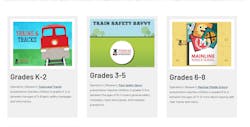Rail Safety Week 2020: Kids can be taught rail safety at any age
With the arrival of fall, children in North America are returning to schools – some for the first time since mid-March – for in-person learning. Operation Lifesaver, Inc. (OLI), and Operation Lifesaver Canada have assembled multiple resources to help parents and educators teach kids of all ages about rail safety.
“Unlike adults, children can’t always focus on one thing at a time and they aren't as good at sensing or predicting danger. That’s why it’s critical to teach them to only cross tracks at designated railway crossings; to take the safest path to school and never use tracks as a shortcut; and not to walk or play on tracks or railway property,” Operation Lifesaver Canada included in a blog post earlier this month.
For children in kindergarten through grade 5, Operation Lifesaver Canada recommends it storybook-style presentation “Train and the Whateveritwas” to introduce important messages regarding rail safety. For the older kids in this set, Operation Lifesaver Canada also has an activity sheet, “Train Your Brain,” designed to be educational and fun. The activity sheet is available in nine languages.
OLI has additional resources for kids in grades 3-5 with its “Train Safety Savvy” presentation that covers general safety messages, signs and signals and trespass prevention.
Children in grade 6 through 8 are more independent and OLI and Operation Lifesaver Canada have resources tailored to this group who may not understand how quiet or at what speed trains can approach.
“It’s critical that they understand this so they don’t make the mistake of walking along railway tracks, or using tracks as a shortcut home,” explained Operation Lifesaver Canada.
The recommended rules to teach include:
• Cross tracks only at designated railway crossings.
• Always stop, look and listen in both directions before crossing railway tracks.
• Never play on or near railway tracks or trains.
• Never throw things at trains or place things on railway tracks.
OLI’s “Mainline Middle School” covers these lessons and additional ones, such as the information that a train is at least three feet wider than the track it travels on.
Operation Lifesaver Canada explains teenagers are the most at risk of being involved in a rail incident either as a result of trespassing or at a crossing.
In the U.S., data from the Federal Railroad Administration shows of all the reported highway-rail crossing incidents to occur since 2017, 11 percent involve drivers age 18-24. Trespassing incidents for the same time period show more than eight percent of trespassers were 13-19-years old.
Operation Lifesaver recommends key safety messages for this age group include:
• Keeping off cell phones when around tracks and trains.
• Obeying all railway signs and signals.
• Never using tracks as a shortcut.
• Never taking photos on tracks.
• Keeping one ear out when wearing headphones to hear trains

Mischa Wanek-Libman | Group Editorial Director
Mischa Wanek-Libman is director of communications with Transdev North America. She has more than 20 years of experience working in the transportation industry covering construction projects, engineering challenges, transit and rail operations and best practices.
Wanek-Libman has held top editorial positions at freight rail and public transportation business-to-business publications including as editor-in-chief and editorial director of Mass Transit from 2018-2024. She has been recognized for editorial excellence through her individual work, as well as for collaborative content.
She is an active member of the American Public Transportation Association's Marketing and Communications Committee and served 14 years as a Board Observer on the National Railroad Construction and Maintenance Association (NRC) Board of Directors.
She is a graduate of Drake University in Des Moines, Iowa, where she earned a Bachelor of Arts degree in Journalism and Mass Communication.



